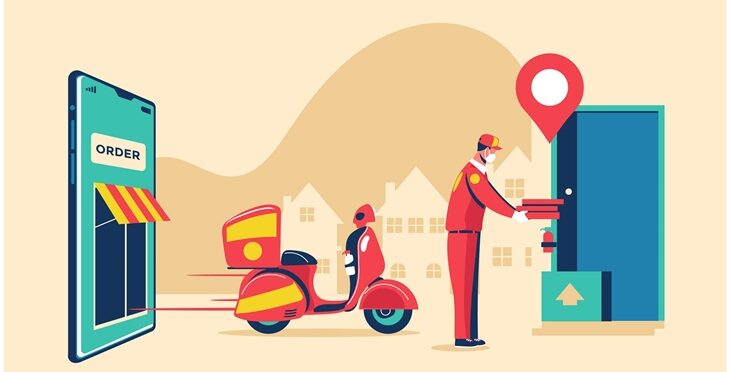What Is A Cloud Kitchen?
Virtual Restaurant Using Cloud Kitchens is a commercial kitchen. It prepares meals for delivery or takeaway and does not serve dine-in customers.
Restaurant operators can use cloud kitchens to grow their business. They can also launch a virtual brand at a low cost. This allows restaurateurs to grow their businesses. It also helps them expand into other markets or test new concepts. Many restaurants employ cloud kitchens as a proving ground for innovative concepts. Doing so also reduces labor and inventory costs.
Restaurant owners employ their own employees and produce in a cloud kitchen concept. Also, the facility and equipment are held by a third party. Several enterprises may use the common cooking space. Each wishing to create dine-at-home meals without the overhead of a restaurant.
Cloud kitchens are often known as virtual restaurants or virtual brands. Moreover, they can help to develop a new business or concept. A virtual brand runs out of an existing kitchen. This allows the company to experiment with new ideas without having to reinvest.
What Are The Advantages Of Cloud Kitchens?
Low Operating Costs
Staffing expenses and compliance with labor rules are two of the most significant difficulties facing restaurant owners. Cloud kitchens can take advantage of on-demand labor. They don't have to worry about service employees.
Compared to traditional eateries, cloud kitchens have a far lower entry barrier. It also removes the need for any front-of-house activities. It also removes the need for floor space for sitting. Also, it avoids exorbitant rents for storefronts with heavy foot traffic in attractive locations. Cloud kitchens have cheap expenses.
Economies of scale also help to save money on ingredients. Making larger orders for a variety of distinct businesses that operate out of the same kitchen. These savings pass on to customers. It gives virtual restaurants an advantage over traditional eateries.
Increased Efficiency
Ghost kitchens can run efficiently if they use custom-built rooms. Also, they need to optimize their procedures only for delivery. You may batch prep ingredients for many different menus. Also, you can configure the kitchen to focus on the speed of preparation and the procedure of turning over meals to delivery drivers.
Real-Time Adaptation And Access To User Data
Cloud kitchens optimize procedures, orders, and staffing. The menu can change to meet demand and boost profitability. Thus allowing the model to improve over time. The restaurant is not tied to a particular location. The menu and operating hours can change to meet the company's needs without affecting client pleasure. This also assists in reducing food waste with informed ordering and preparation decisions.
Digital Brand Awareness With Low Marketing Spend
Virtual restaurant firms can get instant visibility through delivery applications. A new virtual restaurant concept will have to pay for awareness. This is part of the delivery app business model. It can still be less expensive in the long run, especially if you are innovative in your branding.
How To Succeed As A Virtual Restaurant Using Cloud Kitchens?
Select A Concept
The first step is to decide on a ghost kitchen concept. There are a few tactics that can help your virtual restaurant be more successful in this regard.
Look for an underserved niche in your delivery area. Also, if there are no specialized restaurants in your neighborhood, that's an opportunity for a new restaurant to fill that void.
Make sure your notion is optimized for delivery. Moreover, some foods don't travel well at all. Focus on meals that can be packaged and transported without losing quality.
Locate A Location
You'll need to find a certified commercial kitchen. Here you can keep and prepare your food if you're starting from scratch with your cloud kitchen. Moreover, keep delivery radiuses in mind when picking a location. While it may be cheaper to rent space far away from residential areas, it may complicate your delivery procedures.
Also, make sure to follow local laws and requirements for company registration, safe food handling certification, insurance, etc.
Select Your Service Providers
You'll need vendors for your food, packaging, and other materials in the next phase. You can begin the process of selecting a delivery service.
There are many solutions available in this regard. Third-party food delivery apps have surged in popularity in recent years. They offer a quick and easy way to reach local delivery clients via a marketplace framework.
But, there are significant drawbacks to adopting those platforms, including the cost. Most of them charge significant fees, as well as commissions on orders. Cloud kitchen owners see it as a necessary cost of getting in front of customers and avoiding the risks of managing their own drivers.
Create A Logo For Your Virtual Restaurant
Because your restaurant is only available online, it requires a strong digital presence. You can choose from a variety of small business website builders. Restaurant digital toolkits are ideal for cloud kitchens for several reasons:
They assist you in creating and maintaining a website with a dynamic menu that your visitors can interact with.
It provides marketing options to assist you in publicizing your virtual restaurant.
With built-in connectors and the flexibility to use your own delivery team or link to a local network of drivers. All without the commissions and fees that come with delivery apps. It makes online ordering and delivery simple.
Iterate On Successes Using Data
You may examine what works and what doesn't once you start delivering orders from your cloud kitchen. But, you'll need information about your visitors and their orders to do so. Data on online orders, deliveries, and guest behavior are collected by a third-party delivery software, and you get to keep it all.
You can also use automated re-marketing. This also means the platform will use guest data for remarketing to your clients. Thus converting them into regulars without you having to do anything.
7 Cloud Kitchen & Virtual Restaurant Companies
CloudKitchens
CloudKitchens is a ghost kitchen startup that lends space to businesses that prepare meals for delivery. It purchased more than 40 buildings in various locations. This was after a former CEO of Uber Technologies Inc. created a mini-empire of defunct restaurants and warehouses.
Franklin Junction
Franklin Junction pioneered the "Host Kitchen" concept. It also signed an agreement with GrubHub recently. It facilitates the manufacturing and online sales of other menu items. Moreover, the digital platform assists restaurants in monetizing excess kitchen and storage capacity.
Kitchen United
Kitchen United, based in Pasadena, California, is a ghost kitchen firm. It provides restaurants with fully equipped professional kitchen space. This also helps restaurants to prepare and operate delivery-only menu items. They also cut complex POS systems in favor of back-of-house automation and other ordering tools. Moreover, this helps to streamline delivery services.
REEF Technology
The Miami-based parking facilities technology company, once known as ParkJockey Global. It has 5,000 locations across North America. Reef Kitchens business has outfitted its parking facilities with delivery-based cloud kitchens. They're employing those same facilities to enter the virtual restaurant industry.
Virturant
Virturant is a delivery-only virtual restaurant brands firm. It is founded by restaurant and IT industry experts. Virturant helps restaurants increase revenue. It does so by monetizing its unused/underutilized labor, equipment, and kitchen capacity. It also has a turn-key system for attracting new customers via food delivery applications.
Zuul
Zuul is a company based in New York City. It allows chefs to focus on cooking and developing their businesses. Meanwhile, Zuul handles management, technology, and space. The company has also partnered with Thrillist to build a rotating ghost kitchen and a virtual food hall called "Zuul Market."
Conclusion
Because most orders are placed online, technology plays a critical part in cloud kitchens. Taking online orders, processing payments, and efficient kitchen administration is important. For this, a cloud kitchen requires an integrated technology infrastructure.
A point of sale (POS) system that accepts orders from various channels is a must-have for a cloud kitchen. POS can also be delivery aggregators and online ordering platforms.
Moreover, with an integrated restaurant POS system, you can keep track of orders from each channel. You can also see which platform is the most effective for you.
Having access to sales data is essential for establishing sales-boosting strategies. Also, working with online food aggregators is vital. But, it would be best if you also considered creating your own restaurant website or mobile app to accept orders as a secondary sales channel.
You may also like to read:
Cloud ERP For Digital Transformation: How It Helps Companies Transform
Difference Between Software-Defined Networking & Network Virtualization





